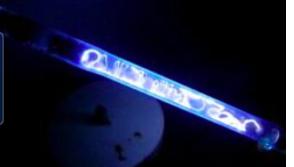
There's an ugly conflict going on at ACSH. Check it out...
I must admit that I am stealing the idea of the Dreaded Chemistry Lesson From Hell© from Dr. Bloom. We will call this the Dreaded Physiology Lesson From Hell©.
Dr. Chuck Dinerstein, Medical Director and serial copyright infringer March 4, 2022
Note that there is no mention of remuneration!
Well, Chuckie, it works both ways. In response, I shall be appropriating your popular "What I'm reading" series. Of course, our reading lists are a bit different (1)...

Seriously, though. You might want to check out the following. Perhaps my favorite book in years. Plenty of science (much of it accurate), a mission to save the sun, and the development of a delightful friendship between an astronaut and a brilliant alien who looks like a five-legged spider the size of a dog. Funny as hell too.
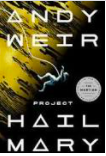
Project Hail Mary, by Andy Weir, the author of The Martian. Awesome.
What does this have to do with the DCLFH© <----- (Big enough for you, Chuckie D.?) Plenty. One of the many fascinating things you'll find in the book is an alien polymer of xenon called Xenonite, something that isn't all that far-fetched (2). The stuff is used as parts of a spaceship and air-tight containers. It is almost indestructible, much like the real element xenon, the subject of todays...
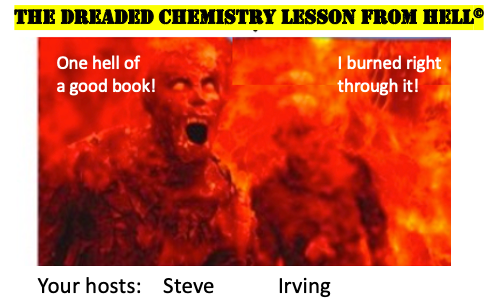
Steve and Irving both enjoyed Project Hail Mary. It's a bit long, but it's not like they're going anywhere.
The Chemistry of Xenon
- Xenon is one of the six noble gases, so-named because they are (mostly) inert, just like the noble metals (gold, platinum, rhodium, others). All of them are in Group VIII on the right side of the periodic table. As such, you have to really beat on them to get helium, neon, argon, krypton, and radon to undergo a chemical reaction.
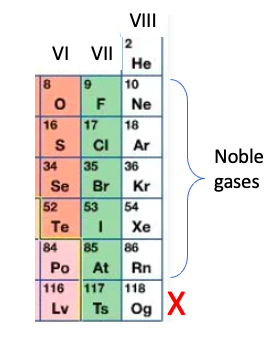
- The red X next to oganesson signifies my distaste for synthetic elements. They don't exist. Anywhere. Instead, they are made by blasting some other poor schmuck of an element with an ungodly amount of energy inside a particle accelerator, roughly the size of Grand Canyon. And the new element sticks around long enough to be measured, and that's it. You will not find them at Costco. Synthetic elements are stupid.
- The name is derived from xenos, which is Greek for stranger.
- Xenon is very rare. Although it is impossible to get a reliable number of how much xenon is found on Earth (if you go to 10 sites, you'll get 11 different numbers), it's clear that it's one of the rarest elements on the planet.
- There is much more xenon on Mars than on Earth. You never know when that tidbit might come in handy. Is this why Elon Musk wants to colonize Mars?
- Even though xenon is so rare, it is used in photography and projection equipment for movies.
- When put inside a vacuum tube and placed in an electric field, it gives off a beautiful blue light.
- You can even buy one of these on eBay!
XENON FLASH STROBE LIGHT tubes Vacuum device
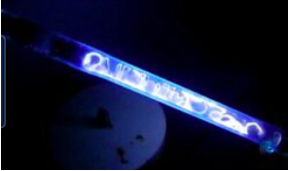
But maybe not right now...

- Xenon is insanely dense: 5.9 grams/liter at normal temperature and pressure. It and radon are the two densest elemental gases. By comparison, here are the densities of some other gases:
- Air - 1.2 g/L
- Oxygen - 1,3
- Hydrogen - 0.09
- Helium - 0.17
- Carbon dioxide - 1.8
It is possible to do some chemistry with xenon. Even though it is inert, xenon does react with fluorine – the most reactive element:
Xe + F2 --------> XeF2 (xenon difluoride)
Don't try this at home. The conditions necessary to promote this reaction are not ordinary. You put the xenon and fluorine (See Fluorine: The Element From Hell) in a sealed nickel container and heat the damn thing to 400°C (752°F). This is not a good location for your head...
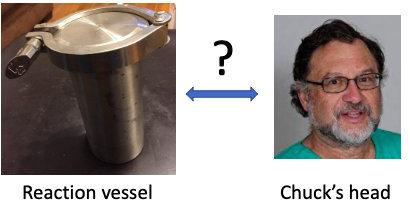
Xeron difluoride, not something you want to gargle with, has an important use. It is the reagent used to make an important cancer drug:

(Left) Synthesis of 5-FU using XeF2. (Right) Scary symbols. I think the middle one is the universal symbol for "do not apply to testicles."
Xenon Tetroxide: Go Boom
Now here's a real beauty. Xenon tetroxide is a pure, unadulterated chemical bomb. For you DCLFH© fans, perhaps you've read Why Stuff Explodes (2016). To keep an already-too-long story shorter, chemicals, such as nitroglycerine, ammonium nitrate, and triacetone triperoxide (3), have a large amount of gas (oxygen, nitrogen, carbon) dioxide) built into the molecule usually contain a lot of energy. In other words, it doesn't take much of a nudge for them to go boom. One of the worst, nitrogen triiodide, can be detonated by touching it with a feather.
Xenon tetroxide puts them to shame. It's a yellow crystalline solid, but you can do all the Google image searches you want, and you won't find a photo of the stuff. This is because it violently detonates at -36°C (-33°F), giving off xenon and oxygen at an alarming rate. This led to a lively discussion on a spaceflight website, where some people argued that it might be a suitable rocket propellant. This got shot down rather quickly:
No, no, no and no. Xenon tetroxide in a rocket does not make a vehicle. It makes a very expensive pipe bomb.
Lajoswinkler, 2014
Believe it or not, it is sold online! Sort of.
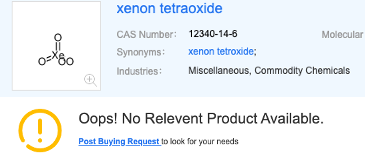
Finally, I looked for a photo or video or the stuff exploding but couldn't find anything. So I had to run the experiment myself. Fortunately, Chuck agreed to help...
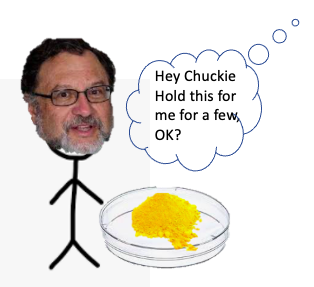
The experiment worked...

Chuckie D. is gonna have even more reading time on his hands
NOTES:
(1) It would be unfair to omit Cameron English from the reading list, although he has had a lot less time on his hands lately.

(2) When put under tremendous pressure, xenon can actually form something like a metal.
(3) TATP is the stuff that idiot shoe bomber tried to set off on a plane.



